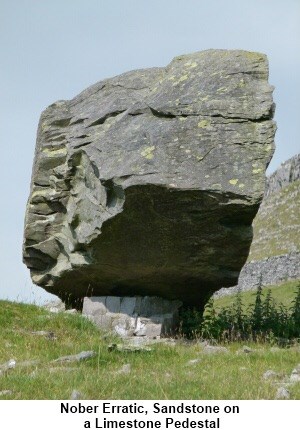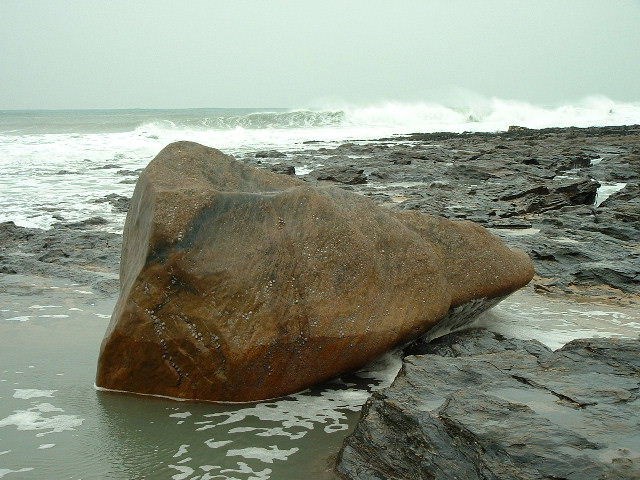Erratic, ![erratic [Credit: Daniel Mayer]](https://imgproxy.geocaching.com/41fe96d5cc5c6fcfd56a25fa5a00e2c07f066296?url=http%3A%2F%2Fmedia-2.web.britannica.com%2Feb-media%2F88%2F131188-004-B750D220.jpg) glacier
glacier-transported
rock fragment that differs from the local bedrock. Erratics may be embedded in
till or occur on the ground surface and may range in size from pebbles to huge boulders weighing thousands of tons. The distance of transportation may range from less than 1 km (0.6 mile) to more than 800 km (500 miles); those transported over long distances generally consist of
rock resistant to the shattering and grinding effects of glacial transport. Erratics composed of unusual and distinctive rock types can be traced to their source of origin and serve as indicators of the direction of glacial movement. Studies making use of such indicator erratics have provided information on the general origins and flow paths of the major ice sheets and on the locations of important mineral deposits. Erratics played an important part in the initial recognition of the last
ice age and its extent. Originally thought to be transported by gigantic floods or by ice rafting, erratics were first explained in terms of glacial transport by the Swiss American naturalist and geologist
J.L.R. Agassiz in 1840.
Glacier Bourne Erratics
Erratics provide an important tool in characterizing the directions of glacier flows, which are routinely reconstructed used on a combination of moraines, eskers, drumlins, meltwater channels, and similar data. Erratic distributions and glacial till properties allow for identification of the source rock from which they derive, which confirms the flow direction, particularly when the erratic source outcrop is unique to a limited locality. Erratic materials may be transported by multiple glacier flows prior to their deposition, which can complicate the reconstruction of the glacial flow.

Ice Rafted Erratics
Glacial ice entrains debris of varying sizes from small particles to extremely large masses of rock. This debris is transported to the coast by glacier ice and released during the production, drift and melting of icebergs. The rate of debris release by ice depends upon the size of the ice mass in which it is carried as well as the temperature of the ocean through which the ice floe passes.

Large Erratics
Large erratics consisting of slabs of bedrock that have been lifted and transported by glacier ice to subsequently be stranded above thin glacial or fluvioglacial deposits are referred to as glacial floes, rafts (schollen) or erratic megablocks. Erratic megablocks have typical length to thickness ratios on the order of 100 to 1. These megablocks may be found partially exposed or completely buried by till and are clearly allochthonus, since they overlay glacial till. Megablocks can be so large that they are mistaken for bedrock until underlying glacial or fluvial sediments are identified by drilling or excavation.
Non Glacial Erratics
In geology an erratic is any material which is not native to the immediate locale but has been transported from elsewhere. The most common examples of erratics are associated with glacial transport, either by direct glacier-borne transport or by ice rafting. However, other erratics have been identified as the result of kelp holdfasts, which have been documented to transport rocks up to 40 centimetres (16 in) in diameter, rocks entangled in the roots of drifting logs, and even in transport of stones accumulated in the stomachs of pinnipeds during foraging.

Erratics and Errosion
As they move along the path of the glacier erratics cause surface of the land to change by knocking chunks out of it and making the land smoother on the leading edge of the glacier or by scratching and scoring it as it moves, this is known as glacial striae. Erosion of the erratic itself will occur as well, large rocks can fracture and split, water can penetrate cracks and crevices making freeze/thaw erosion more likely, wind and rain will erode them over time just as it will to the surrounding landscape.
To log this Earthcache
Please contact me through my profile with the answers to the following questions. Please send me the answers BEFORE you log your find. If you feel you have the correct answers please go ahead and log, I will contact you if there is a problem.
1. Do you think this rock is a glacier bourne erratic, an ice rafted erratic or a non glacial erratic. Why do you think this?
2. Estimate the size of this erratic, creative measurements welcome, describe the colour, texture, shape of it.
3.How many large pieces of rock are there here?
4. Can you think of a reason the large rock has broken into several pieces?
5. Photos are welcome, but please no spoilers.